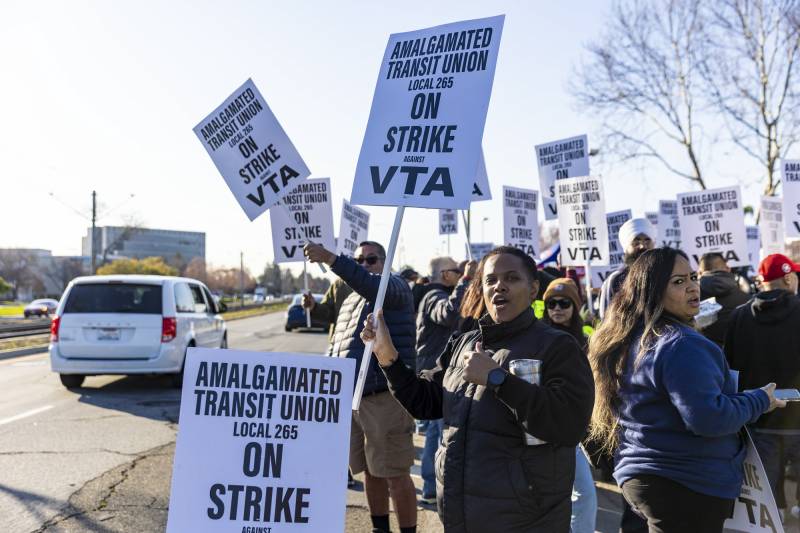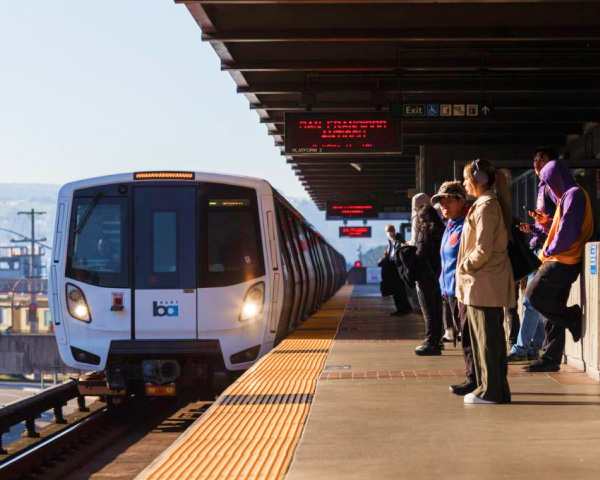Ericka Cruz Guevarra [00:03:04] Okay, so we’re talking about 100,000 people across Santa Clara County who rely on the VTA every day. Now I wanna talk about the strike, which is affecting all of those folks who rely on this agency. Who exactly is on strike right now and what jobs are we talking about?
Joseph Geha [00:03:25] The Amalgamated Transit Union, Local 265, it’s a long name for a union, but that is the local chapter of a very large national transit union. And at VTA, Local 265 represents more than 1 ,500 currently, bus drivers and light rail train operators, as well as a series of other critical functions like maintenance workers who keep those trains and busses operating. as well as customer service agents and dispatchers.
Melissa Rodriguez [00:03:58] A lot of us here don’t want to, but we have to.
Joseph Geha [00:04:00] Melissa Rodriguez is a bus driver, and she’s been doing it for years with VTA.
Melissa Rodriguez [00:04:06] It’s hard to live. A lot of people, a lot of drivers live really far away. They drive two to three hours just to get here, just to go to work, and it’s hard.
Joseph Geha [00:04:16] And I talked to her outside of the Cerone yard. It’s a bus depot in North San Jose. And she’s essentially one of hundreds of workers yesterday who were taking shifts on picket lines and protesting essentially what they believe is an unfair contract.
Melissa Rodriguez [00:04:32] People that I’ve had on my bus, they were supportive. They said they had to find other avenues to go ahead and get to where they needed to get to. I feel really bad, but if we don’t do anything about this now, we’re just gonna continue to fight like this back and forth.
Ericka Cruz Guevarra [00:04:54] Yeah, let’s talk about that a little bit more, Joseph. Why exactly is this strike happening? And I guess how did we get here?
Joseph Geha [00:05:01] It’s been months and months of negotiations. ATU members were negotiating for a new contract. Their current contract expired in early March, but they’ve been negotiating with the agency to hammer out a new contract since August. Despite that, you know, more than six month negotiation period where for most weeks they were meeting twice a week, they were unable to get the contract completely figured out. And the two sides, the agency and the union, they remain really far apart on these critical issues like wages, as well as how employee grievances are handled and a couple of other issues that are important to the union right now.
Ericka Cruz Guevarra [00:05:50] What exactly are these VTA workers asking for? What are their demands?
Joseph Geha [00:05:57] Yeah, the biggest one right now, at least in terms of, you know, on paper, where they’re farthest apart is wages. So the VTA made its most recent offer to the union in late February, on February 28th, and they were offering a 9 % raise to these drivers, operators, and other workers over a period of three years. Meanwhile, on the other hand, you’ve got the union on that same day making their most recent ask. And for wages, they are asking for 18%. So they want a 6 % raise in each of the three years that this contract would cover. The union is asking for double what the agency is offering. So that is one of the biggest chasms, I guess, you could say. One of the bigger sticking points is the arbitration issue. So essentially, this is the way that the union and the agency work out disputes. When there is a problem with the way a worker was treated in the view of the union, they can bring a grievance to the agency. and that can sometimes go into the arbitration process. The ATU and the VTA have been meeting for months and negotiating multiple times a week up until this strike occurred. And the negotiation team for the union includes its president, Raj Singh, and he has been characterizing these negotiations in a really negative light.
Raj Singh [00:07:13] Negotiations have not been in good faith, you know, the communication was very poor. The agency has stuck to their normal routine that it’s, you know, it’s used for every single negotiations that I’ve seen in my 17 years of employment here.
Joseph Geha [00:07:29] He said that the agency is wasting the union’s time for the first several months of the negotiations and not addressing real issues and not making what the union considers to be real substantive offers in terms of wages. He has kind of lambasted the agency and claimed that they are the reason this strike is happening.
Raj Singh [00:07:49] We’re asking for the agency to, you know, present something that they believe is fair. We want to get this done sooner rather than later.
Ericka Cruz Guevarra [00:08:01] Wow, strong words there. And also seems like there’s just a lot going on here. The union and the agency being very far apart on wages and this sort of conflict resolution process. I mean, how has VTA responded to all of this and especially these demands?
Joseph Geha [00:08:24] Yeah, I mean, I think there’s been some nearly equally strong words coming from the VTA.
Greg Richardson [00:08:32] Let me first start by saying how disappointed we are with the action taken last night by ATU Local 265 with their communication to our board of their intent to strike.
Joseph Geha [00:08:45] you’ve got the deputy general manager of VTA, his name’s Greg Richardson, and he has, you know, been interviewed a million times by local media as well as held press conferences where he has decried what he calls a decision, a choice by the union to basically abandon a hundred thousand people every day.
Greg Richardson [00:09:05] you know these are folks who are trying to get to their job and if they’re not aware of it and they’re having a clock in clock out i mean this is going to be something that that could impact them dramatically and uh… it’s not something that we want to see.
Joseph Geha [00:09:18] The other thing that Greg Richardson and VTA spokespeople have noted is that there simply in their view is not enough money in the piggy bank, so to speak, to meet the union where they are asking to be met.
Greg Richardson [00:09:33] ATU’s demand is for a 19 .1 % increase over three years. The reality, with a wage increase at this level, or anything close to it, would be service cuts throughout our system and the likely elimination of positions across VTA.
Joseph Geha [00:09:50] Richardson has said, you know, it’s going to be a little bit of a fiscal challenge for the agency to be able to meet the offer that they’ve already made at 9%, but they’re willing to do that and they are committed to doing that without having to cut, first of all, any employees or cut any service.
Greg Richardson [00:10:06] You know, do we want to keep the ridership going? Of course. I mean, the momentum that VTA has gained over the last 18 to 24 months has been dramatic, but it’s more important about the impact it’s going to have on those riders.
Ericka Cruz Guevarra [00:10:21] And as we’re talking Joseph, it’s day two now of the strike. How has it gone so far?
Joseph Geha [00:10:27] Yeah, day one was interesting. Spirits were high, a lot of strikes with labor unions often start early in the morning, and there’s no exception here. You had workers kind of in line with their shifts, right? Because bus drivers and train operators, they get up before the crack of dawn in some cases. And so you had folks picketing outside of five locations that are run by the VTA, including their headquarters in North San Jose, and you had folks out there in the dark of night, essentially around four in the morning. beginning their picketing and their chanting of slogans and, you know, basically just making a public show of force that they won’t be ignored and that their demands are serious.
There was an incident in the morning at the Cerone yard where there’s this pickup truck driven by what ATU says was a VTA supervisor that kind of made contact with a couple of the picketers. And there was a dispute about whether he collided with them on purpose or what was happening. But it was a really messy situation. A couple of people got sent to the hospital just to make sure they were okay with some minor injuries. but overall that incident really increased the tensions. VTA, for its side, is saying that the picketing workers were at fault, essentially blocking the car’s way, the pickup truck’s way, and kind of getting in the way of the car on purpose. So there seems to be a lot of disagreement, but either way, nobody is happy about this incident with the pickup truck.
Ericka Cruz Guevarra [00:11:53] I mean, what impact is this having so far on riders in the county, Joseph? I mean, because obviously no one, it seems like, is driving the busses. So are none of the trains or busses operating right now? I mean, what does this all mean for riders?
Joseph Geha [00:12:14] Yeah, not a single bus or train, light rail train, from VTA is running right now and has not been running since just after midnight on Monday.
Sheila Mirrielees [00:12:23] And so there’s a strike that I didn’t listen to the news this morning. So now I have to take an Uber out to Mountain View.
Joseph Geha [00:12:32] Sheila Mirrelees of Mountain View took Cal Train and BART into work in Oakland in the morning but was coming back through BART and planned to take a VTA light rail train back home in the afternoon and she found out after walking the footbridge over to the light rail station that there were going to be no trains this week or that day.
Sheila Mirrielees [00:12:53] I saw people walking back but they didn’t tell me so yeah, I walked all the way over there, so
Joseph Geha [00:12:58] A lot of people have mixed feelings about when a public agency workforce like this goes on strike and affects so many people on a daily basis. But some of those people who were directly affected, like Sheila, still have empathy and understanding for this workforce and what they’ve chosen to do here to get a better contract.
Sheila Mirrielees [00:13:19] People just don’t go on strike for the fun of it. There’s something going on in their lives or they really need to for the most part.
Ericka Cruz Guevarra [00:13:30] Joseph, you’ve talked to both the union and the VTA at this point. Any sense on how long this could last?

